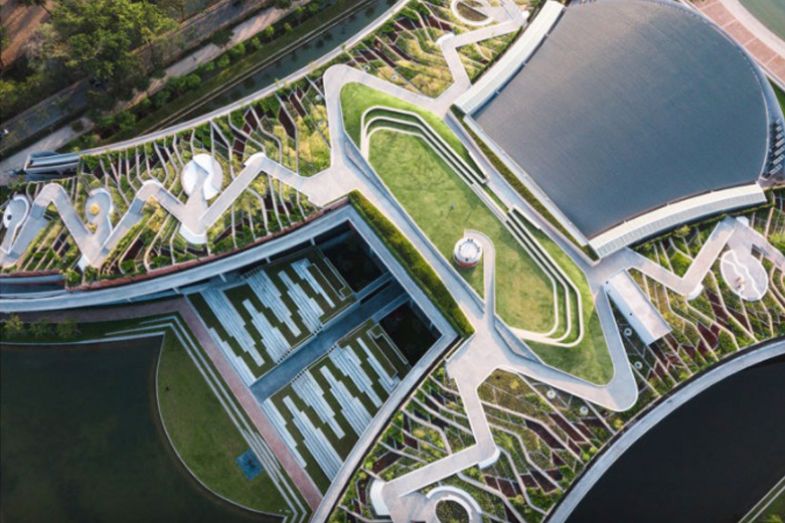
By mimicking traditional rice terraces, Thammasat University Urban Farming Green Roof has become an all-in-one solution–as a public green space, urban organic food source, water management system, energy house, and outdoor classroom–which serves as an adaptation model for anticipated climate impacts that can be implemented and developed across Thailand and Southeast Asia.
Bangkok and cities in Southeast Asia are among the most vulnerable to climate impacts in the world.
But just a short trip away, a new integrative solution at Thammasat University (TU) has emerged to create climate resiliency, demonstrating how development can contribute more solutions than the problems it has created by embracing landscape architecture and past agricultural practices. As the largest urban rooftop farm in Asia, the 22,000 sq. m. (236,806 sq. ft.) Thammasat University Green Roof tackles climate impacts by incorporating modern landscape architecture with traditional agricultural ingenuity, the green roof, urban farming, solar roof and green public space.
The project combines the elements of ‘architecture’ and ‘landscape architecture’ so seamlessly that it is almost impossible to categorize what type of work it actually is. The form of the building is developed from the H-shaped floor plan, rendering the elevation that resembles a large mountain with a massive green space of garden covering upper part.
Reclaiming the Paddy Fields of Rangsit
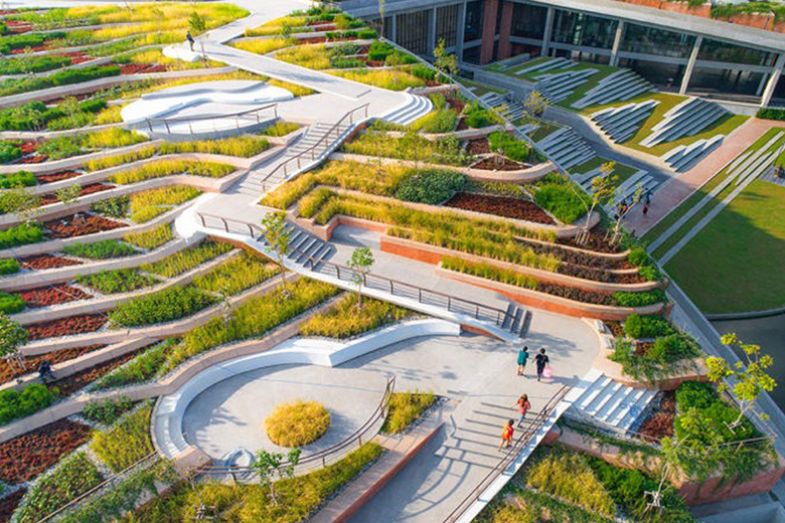
To revive the land on which it stands on, Thammasat University, one of Thailand’s leading universities, has created the innovative architecture by transforming an unused rooftop into a solution to climate, food, and pollution crisis. Any runoff is filtered through each layer of soil and later saved up in four retention ponds, which can collect the water up to 11,718 Cubic meters (3,095,570 gallon) for rooftop irrigation and future use
Managing Water on Mountain of Rice Fields
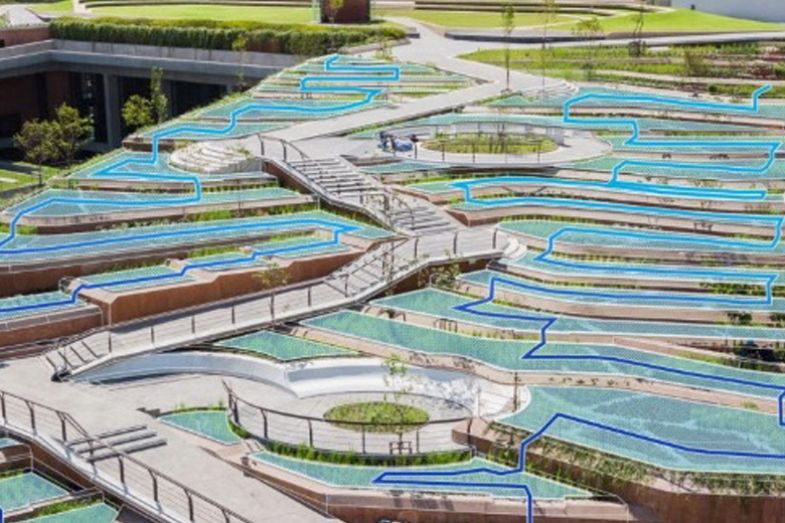
During heavy rainfalls, abundant soil mass and nutrients can be lost in along with the runoff. But with cascading layers of planters, the plants on the Thammasat University Green Roof hold the soil together and slowdown runoff. By embracing not only the intention of organic, but also regenerative agriculture, it ensures a food source beneficial to both the health of humans and nature. With each cascading level, the green roof is not only able to absorb rainwater, but also slow down runoff, both for up to 20 times more than a normal concrete rooftop.
Building Climate-Resilient Cities from Wasted Concrete Space
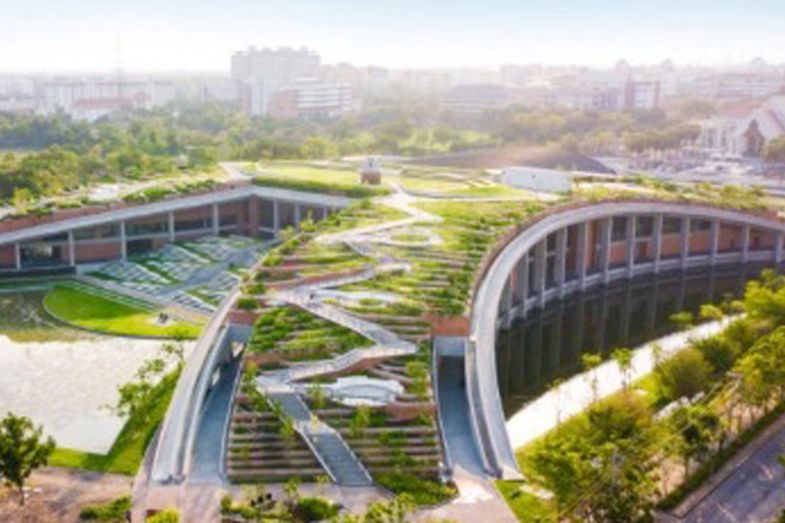
Instead of another wasted rooftop which contributes to urban heat islands, the mountain-shaped Thammasat University Green Roof utilizes its vast space as an infinite source of clean energy, not only in terms of organic food, but also solar power for the community.
Taking advantage of the abundance of sun Thailand receives, the Thammasat University Green Roof harnesses readily available solar energy at zero production cost and produces 500,000 watts (equivalent to 25,000 electric light) per hour to pump water for irrigation on its urban farm, as well as generate electricity inside the building underneath it.
Feeding the People from a Single Rooftop
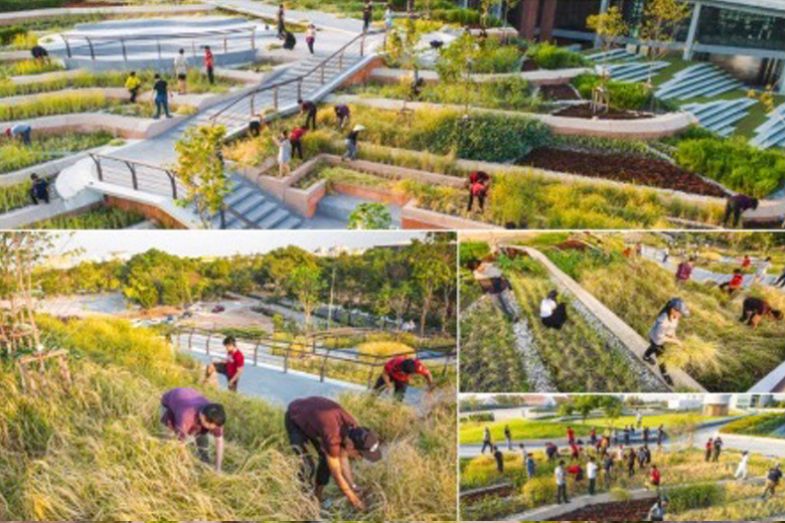
By utilizing traditional ingenuity from rice farmers on the sloped hill and mountain terrains across Southeast Asia, the Thammasat University Green Roof can grow up to approximate 135,000 rice meals each year to feed the community. While the urban rooftop farm holds the key to Thammasat University Green Roof’s functions, the green canteen completes its intended purpose of creating a truly holistic and sustainable model for business and conservation.
Creating a Localized, Sustainable, and Circular Economy
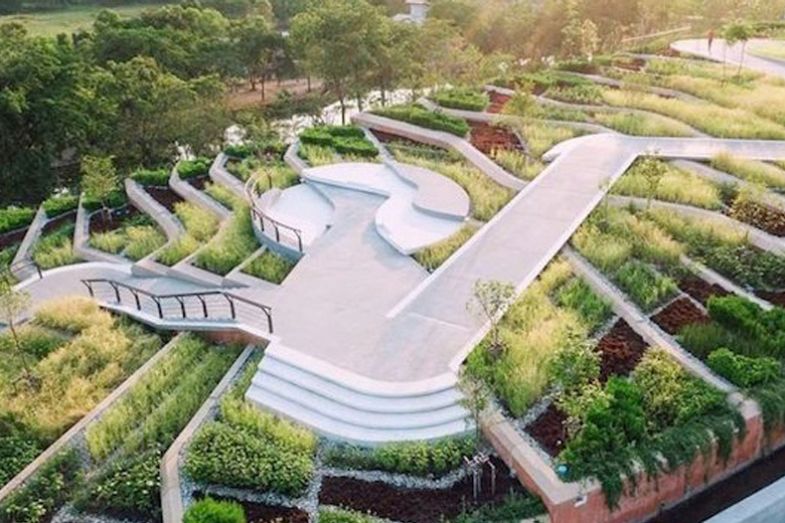
To help damaged ecosystems, contaminated food sources, and undercompensated farmers recover from the aftermath of industrialized agriculture–a system which shifted power from local manpower to machinery and foreign imports–the Thammasat University Green Roof creates employment for students and staff inside and surrounding the campus, while giving them the opportunity to contribute to feeding the community and conserving the ecosystem through sustainable agricultural practices.
Passing on Land and Knowledge to the Next Generation
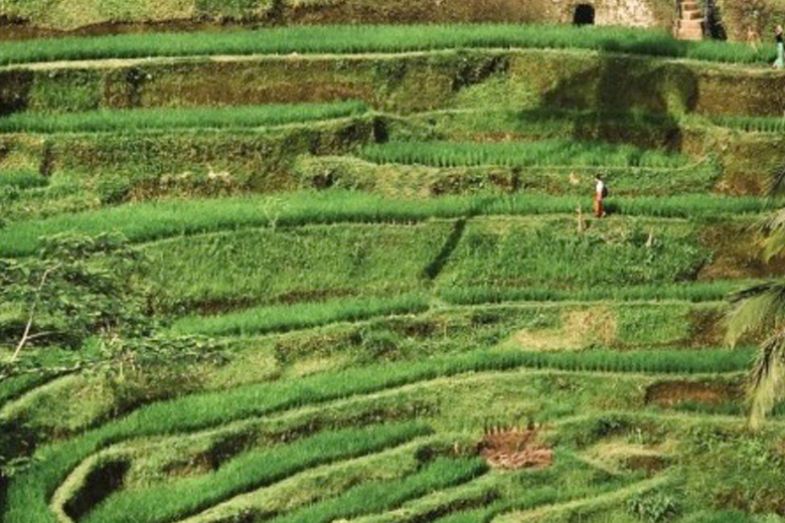
The Thammasat University Green Roof also serves as a platform for outdoor learning and social interaction across various disciplines within campus. It aims to educate the community of the impacts, causes, and solutions of climate change–which is an umbrella to both the ecological and human rights lens of the food, energy, and waste industry, as well as water management, financial economy, and governance–to ground them with information to reflect on their personal carbon footprint and share their newfound knowledge with their social networks.
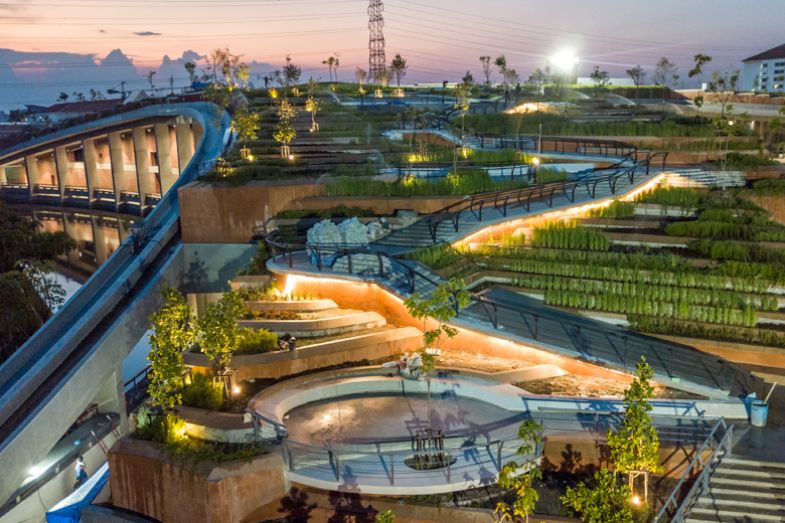
This holistic solution was all inspired by the local ingenuity, carried on by several generations of farmers who learned from the land and water they lived with. To show our young leaders how to welcome challenges of the uncertain future, past knowledge about the origins of their culture and native soil have been embedded in the Thammasat University Green Roof as lessons for them to adapt and take steps forward.
Thammasat University, Rangsit Campus
Location | Bangkok, Thailand
Building Type | Multi-Purpose Building with the Biggest Urban Farming Green Roof in Asia
Project Owner | Thammasat University
Landscape Designer and green roof design | LANDPROCESS (Kotchakorn Voraakhom)
Architect | Arsom Silp Institute Of The Arts
Structural Engineer | Degree System Co., Ltd
System Engineer | TPM Consultants Co., Ltd
Contractor | CM49
Project Information
Green Roof Area: 22,000 sq. m. (236,806 sq. ft)
Urban Farming Area: 7,000 sq. m. (75,300 sq. ft) 32%
Solar Roof Area 3,565 sq. m. (38,373 sq. ft.) 16%
Public Space Area 7,000 sq. m. (75,300 sq. ft.) 32%
Service and Utility 4,435 sq. m. (47,738 sq. ft.) 20%
Building Area: 60,000 sq. m (645,840 sq. ft.)
Images & Diagrams | Courtesy of LANDPROCESS
https://worldlandscapearchitect.com/thammasat-university-the-largest-urban-rooftop-farm-in-asia/#.XihAY1MzbuR













